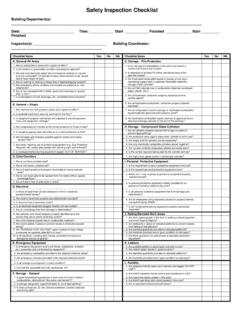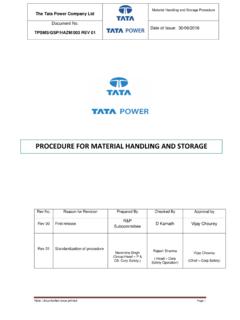Transcription of MILLING MACHINE OPERATIONS - HNSA
1 SUBCOURSEEDITIONOD16448 MILLING MACHINE OPERATIONSUS ARMY WARRANT OFFICER ADVANCED COURSEMOS/SKILL LEVEL: 441 AMILLING MACHINE OPERATIONSSUBCOURSE NO. OD1644 EDITION 8US Army CorrespondenceCourse Program6 Credit HoursNEW: 1988 GENERALThe purpose of this subcourse is to introduce the student to the setup, OPERATIONS and adjustments of the MILLING MACHINE , which includes a discussion of the types of cutters used to perform various types of MILLING credit hours are awarded for successful completion of this 1: MILLING MACHINE OPERATIONSTASK 1:Describe the setup, operation, and adjustment of the MILLING 2:Describe the types, nomenclature, and use of MILLING MACHINE OPERATIONS - OD1644 TABLE OF OF 1: MILLING MACHINE 1:Describe the setup, operation,and adjustment of the MILLING 2:Describe the types, nomenclature,and use of MILLING Exercise to Practical Exercise MACHINE OPERATIONS - OD1644 When used in this publication "he," "him," "his," and "men" represent both the masculine and feminine genders, unless otherwise MACHINE OPERATIONS - OD1644 STUDENT NOTESivMILLING MACHINE OPERATIONS - OD1644 - LESSON 1/TASK 1 LESSON 1 MILLING MACHINE OPERATIONSTASK the setup, operation, and adjustment of the MILLING a self-study environment and given the subcourse text, without three hoursREFERENCESNo supplementary references are needed for this machines were first invented and developed by Eli Whitney to mass produce interchangeable musket parts.
2 Although crude, these machines assisted man in maintaining accuracy and uniformity while duplicating parts that could not be manufactured with the use of a and improvements of the MILLING MACHINE and components continued, which resulted in the manufacturing of heavier arbors and high speed steel and carbide cutters. These components allowed the operator to remove metal faster, and with more accuracy, than previous machines. Variations of MILLING machines were also developed to perform special MILLING OPERATIONS . During this era, computerized machines have been developed to alleviate errors and provide better quality in the finished MACHINE OPERATIONS - OD1644 - LESSON 1/TASK The MILLING MACHINE removes metal with a revolving cutting tool called a MILLING cutter. With various attachments, MILLING machines can be used for boring, slotting, circular MILLING dividing, and drilling. This MACHINE can also be used for cutting keyways, racks and gears and for fluting taps and MILLING machines are basically classified as being horizontal or vertical to indicate the axis of the MILLING MACHINE spindle.
3 These machines are also classified as knee-type, ram-type, manufacturing or bed-type, and planer-type MILLING machines. Most machines have self-contained electric drive motors, coolant systems, variable spindle speeds, and power-operated table feeds.(1)Knee-type MILLING Machines. Knee-type MILLING machines are characterized by a vertical adjustable worktable resting on a saddle supported by a knee. The knee is a massive casting that rides vertically on the MILLING MACHINE column and can be clamped rigidly to the column in a position where the MILLING head and the MILLING MACHINE spindle are properly adjusted vertically for operation.(a)Floor- mounted Plain Horizontal MILLING MACHINE (figure 1 on the following page).1 The floor- mounted plain horizontal MILLING MACHINE 's column contains the drive motor and, gearing and a fixed-position horizontal MILLING MACHINE spindle. An adjustable overhead arm, containing one or more arbor supports, projects forward from the top of the column.
4 The arm and arbor supports are used to stabilize long arbors, upon which the MILLING cutters are fixed. The arbor supports can be moved along the overhead arm to support the arbor wherever support is desired. This support will depend on the location of the MILLING cutter or cutters on the knee of the MACHINE rides up or down the column on a rigid track. A heavy, vertical positioned screw beneath the knee is used for raising and lowering. The saddle rests upon the knee and supports the worktable. The saddle moves in and out on a dovetail to control the crossfeed2 MILLING MACHINE OPERATIONS - OD1644 - LESSON 1/TASK 1of the worktable. The worktable traverses to the right or left upon the saddle, feeding the workpiece past the MILLING cutter. The table may be manually controlled or power 1. PLAIN MILLING MACHINE -KNEE TYPE.(b)Bench-type Plain Horizontal MILLING MACHINE . The bench-type plain horizontal MILLING MACHINE is a small version of the floor- mounted plain horizontal MILLING MACHINE ; it is mounted to a bench or a pedestal instead of directly to the floor.
5 The MILLING MACHINE spindle is horizontal and fixed in position. An adjustable overhead arm and support are provided. The worktable is 3 MILLING MACHINE OPERATIONS - OD1644 - LESSON 1/TASK 1generally not power fed on this size MACHINE . The saddle slides on a dovetail on the knee providing crossfeed adjustment. The knee moves vertically up or down the column to position the worktable in relation to the spindle. (c)Floor- mounted Universal Horizontal MILLING basic difference between a universal horizontal MILLING MACHINE and a plain horizontal MILLING MACHINE is in the adjustment of the worktable, and in the number of attachments and accessories available for performing various special MILLING OPERATIONS . The universal horizontal MILLING MACHINE has a worktable that can swivel on the saddle with respect to the axis of the MILLING MACHINE spindle, permitting workpieces to be adjusted in relation to the MILLING universal horizontal MILLING MACHINE also differs from the plain horizontal MILLING MACHINE in that it is of the ram type; , the MILLING MACHINE spindle is in a swivel cutter head mounted on a ram at the top of the column.
6 The ram can be moved in or out to provide different positions for MILLING OPERATIONS .(2)Ram-type MILLING Machines.(a)Description. The ram-type MILLING MACHINE is characterized by a spindle mounted to a movable housing on the column, permitting positioning the MILLING cutter forward or rearward in a horizontal plane. Two widely used ram-type MILLING machines are the floor- mounted universal MILLING MACHINE and the swivel cutter head ram-type MILLING MACHINE .(b)Swivel Cutter Head Ram-type MILLING MACHINE (figure 2 on the following page). A cutter head containing the MILLING MACHINE spindle is attached to the ram. The cutter head can be swiveled from a vertical to a horizontal spindle position, or can be fixed at any desired angular position between the vertical and horizontal. The saddle and knee are driven for vertical and crossfeed adjustment; the worktable can be either hand driven or power driven at the operator's Components.
7 The machinist must know the name and purpose of each of the main parts of a MILLING MACHINE to understand the operations4 MILLING MACHINE OPERATIONS - OD1644 - LESSON 1/TASK 1 FIGURE 2. SWIVEL CUTTER HEAD RAM-TYPE MILLING MACHINE OPERATIONS - OD1644 - LESSON 1/TASK 1discussed in this text. Keep in mind that although we are discussing a knee and a column MILLING MACHINE , this information can be applied to other types. Use figure 1 on page 3 (which illustrates a plain knee and column MILLING MACHINE ) to help become familiar with the location of the various parts of these machines.(1)Column. The column, including the base, is the main casting which supports all other parts of the MACHINE . An oil reservoir and a pump in the column keeps the spindle lubricated. The column rests on a base that contains a coolant reservoir and a pump that can be used when performing any machining operation that requires a coolant. (2)Knee. The knee is the casting that supports the table and the saddle.
8 The feed change gearing is enclosed within the knee. It is supported and can be adjusted by the elevating screw. The knee is fastened to the column by dovetail ways. The lever can be raised or lowered either by hand or power feed. The hand feed is usually used to take the depth of cut or to position the work, and the power feed to move the work during the machining operation.(3)Saddle and Swivel Table. The saddle slides on a horizontal dovetail, parallel to the axis of the spindle, on the knee. The swivel table (on universal machines only) is attached to the saddle and can be swiveled approximately 45 in either direction.(4)Power Feed Mechanism. The power feed mechanism is contained in the knee and controls the longitudinal, transverse (in and out) and vertical feeds. The desired rate of feed can be obtained on the MACHINE by positioning the feed selection levers as indicated on the feed selection plates.
9 On some universal knee and column MILLING machines the feed is obtained by turning the speed selection handle until the desired rate of feed is indicated on the feed dial. Most MILLING machines have a rapid traverse lever that can be engaged when a temporary increase in speed of the longitudinal, transverse, or vertical feeds is required. For example, this lever would be engaged when positioning or aligning the MACHINE OPERATIONS - OD1644 - LESSON 1/TASK 1 NOTEFor safety reasons, extreme caution should be exercised while using the rapid traverse controls.(5)Table. The table is the rectangular casting located on top of the saddle. It contains several T-slots for fastening the work or workholding devices. The table can be moved by hand or by power. To move the table by hand, engage and turn the longitudinal hand crank. To move it by power, engage the longitudinal directional feed control lever. The longitudinal directional control lever can be positioned to the left, to the right, or in the center.
10 Place the end of the directional feed control lever to the left to feed the table to the left. Place it to the right to feed the table to the right. Place it in the center position to disengage the power feed, or to feed the table by hand.(6)Spindle. The spindle holds and drives the various cutting tools. It is a shaft, mounted on bearings supported by the column. The spindle is driven by an electric motor through a train of gears, all mounted within the column. The front end of the spindle, which is near the table, has an internal taper machined on it. The internal taper (3 1/2 inches per foot) permits mounting tapered-shank cutter holders and cutter arbors. Two keys, located on the face of the spindle, provide a positive drive for the cutter holder, or arbor. The holder or arbor is secured in the spindle by a drawbolt and jamnut, as shown in figure 3 on the following page. Large face mills are sometimes mounted directly to the spindle nose.







